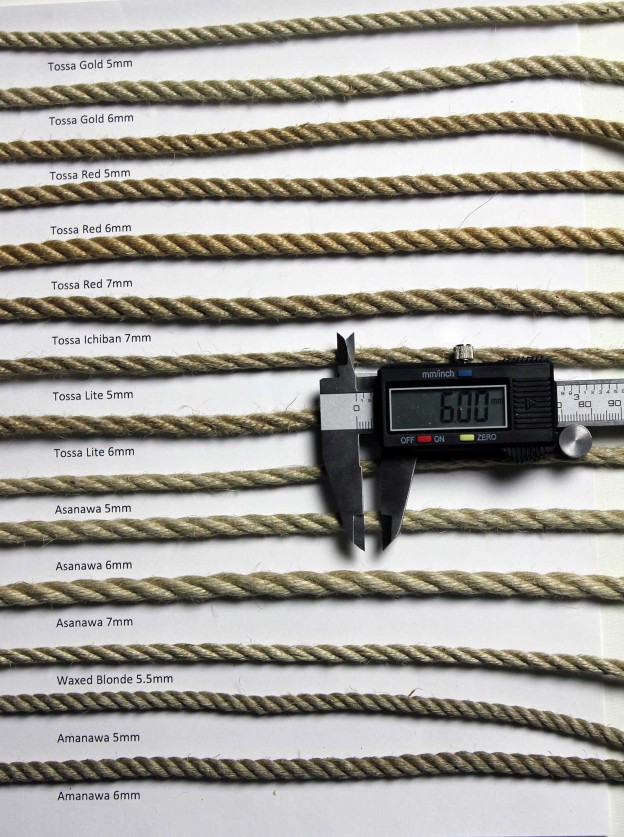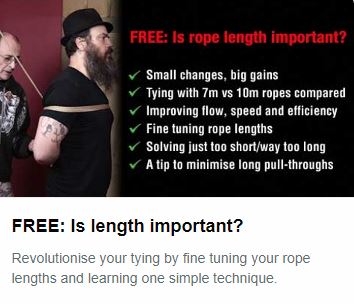IMPORTANT NOTE:
For legal reasons, I do not warrant any natural fibre rope as suitable for supporting a human load. Technically, a safe margin is 5x-10x the weight of the load but, even so, natural fibre is subject to far too many unknowns and variables for any manufacturer to warrant a breaking strain. At best, we can make rough estimates. This can be under 100kg for a true 5mm jute in perfect condition. Bear in mind that almost all rope sizes are nominal and can vary by around +/- 10%-15%.
Dynamic suspension loads, e.g. fast lifts, and friction can increase the stress by up to 250%! Rope suspension is dangerous even if you use rated equipment. Be very sure you possess the skills and understand the risks.
You will find some videos simulating how ropes break in real life on my YouTube channel. I promise that the results will surprise you.
What is the best shibari rope?
"What is the best rope for bondage?" and "What are the differences between hemp and jute rope?" are very common questions? I can see why you might be confused, especially with a range as wide as ours.
People do find choosing rope online difficult unless they have had a recommendation from a friend or have seen it in use. Thankfully, I get a lot of referrals like that and many loyal customers as a result. Anyway, I made a short video where I sit down and show you the various rope ranges. I explain in simple terms the differences, how much work, if any, they need to properly conditioned and generally how it performs. You'll find more specific and current overviews in each product category.
A comparison chart
To give you an easy way to compare the colour and diameter of my various ropes, here they are side by side. This chart is quite old, so some products have been superceded or are no longer available. See idividual listings for latest specification and availability.

How to choose rope and care for it?
This video, an extract from my tutorial DVDSs 'Japanese Rope Bondage', explains the differences bewteeen various types of rope and how to treat rope for use.
How long is a piece of string?
The question I am often asked is what length, type and thickness of rope should I use? If you want a strict answer, kinbaku is typically performed with equal length ropes of 7m-8m. Whilst there may be historical reasons for the length, it is certainly easy to handle and means you never have to worry about which rope you pick up. The standard ties are designed to work with these lengths, although sometimes slight adjustments in length can aid in tying particular elements more elegantly. For example, I prefer a rope nearer 8m for tying an Osada Steve style takate-kote as it allows me to tie and cinch the first wrap with one piece. There is a lot to be said, however, for ensuring a rope is no more than 4 x the span of your out-stretched arms. This means the rope can be pulled through in one movement, as you will be using it doubled, which is fast and fluid. As ropes can be extended by simply forming a lark’s head on the additional rope and slipping it over the knotted end of the last, there is no need for a selection of extra long lengths. If you make your joins as late as possible and, when untying, remove them as soon as you can, it will save much pulling through of rope and speed up your work.
Whether there comes a stage when rope lengths are so outside the norm that it ceases to be shibari is a subject for endless debate. However, I believe that there is a stage when football can no longer be called such if the ball is radically non-standard and thus it is with shibari. That is not to say the game is not as much fun, just that it should then be called something different. Take a look at this free video: Is length important?

What sort?
In Japan, jute is the rope of choice, although is not used exclusively. It is easy to see why as it handles beautifully and is very light compared to hemp. Due to the nature of kinbaku technique, the rope must be ‘grippy’ to hold knots well and have minimal stretch. This means that natural fibre is ideal, since many synthetics can be too slippery or too stretchy. Also, it is more difficult to cause rope burn with a natural fibre and it doesn’t heat up as much when pulled across skin. Twisted 3-ply rope is much favoured as it leaves characteristic indentations when it is removed, something which many people find as beautiful as the bondage itself.
Interestingly, I have recently learnt that ‘Japanese hemp’ is a misnomer as, apparently, very few use hemp rope in Japan. The Japanese language does not differentiate between jute and hemp and it is merely a quirk of on-line dictionaries that first component of ‘asanawa’, ‘asa’ has been translated as ‘hemp’ rather than jute (nawa meaning rope). Source: TokyoBound. Some confusion might also be due to the two meanings of hemp. Most of us associate hemp with rope made from the cannabis genus. However, there is also another more generic meaning which refers to any rope made from bast fibre, which refers to the fibres that grow on the outside of the woody interior of the plant’s stalk, and under the outer most part (the bark). Under this definition, jute could also be called hemp. (Merriam-Webster: a fibre (as jute) from a plant other than the true hemp; also : a plant yielding such fibre).
I’m not a big fan of hemp as I find it smelly, heavy and rather dead in my hands but I know many people swear by it and go into ecstasy at its farmyard aroma. I also find that it can have a rather ‘linty’ appearance, especially with use, whereas jute will become polished. The feel and look of jute and hemp can be improved with treatment. In most cases, this involves boiling or hot washing, although I would avoid doing this to loosely woven jute, e.g. some Japanese rope, as it can open up the weave too much. My referred washing method is a dishwasher as, due to the lack of agitation that you would get in a washing machine, the twist stays tighter. Once washed, I dry the rope under tension, strung out like a washing line. When it’s dry, I will then burn off the ‘fuzzies’ over a gas cooker. Finally, I will dampen a rag with a little tsubaki oil (Camellia Japonica) and draw the rope through it several times. Tsubaki is a traditional treatment for wood and metal, being a natural preservative. It’s also very popular cosmetically in Japan for hair, nails and skin. Although many Japanese nawashi favour bayu, not all Westerners are comfortable using something made from horse fat. Furthermore, it has the potential to go rancid.
If you don’t want to go to the hassle of treating rope or cost of pre-treated, there is now a new kid on the block: Linen hemp. This can come as an extremely fine rope with a beautiful feel and the heft of hemp, best of all it can be used untreated. I have branded my custom produced linen rope as Amanawa. This has an incredible 40 or so yarns per ply, resulting in a very smooth and consistent rope which leaves crisp marks. It can also be the solution for those with allergies. It has the strength of hemp or jute, so, unlike cotton, is better suited for load-bearing work.
As for thickness, around 6mm is used for suspension and thinner cord is often used for floor-work or detail, e.g. 4mm. I find that anything more than 6mm becomes hard to work with and that it produces bulky knots, which can be ugly and cause discomfort. You can find a wide selection of ropes in various diameters here in my store.
All in all, it is what works for you but these ‘standards’ have emerged from a lot of experience. There is good reason why they are the way they are.
